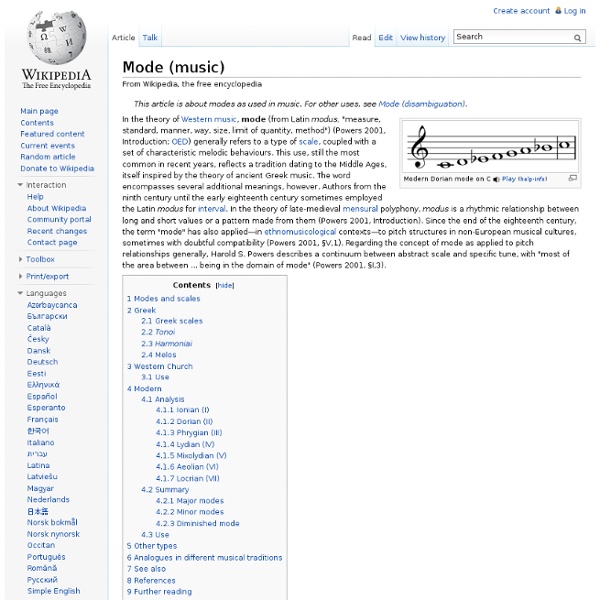Orchestration
Orchestration is the study or practice of writing music for an orchestra (or, more loosely, for any musical ensemble) or of adapting for an orchestra music composed for another medium. Only gradually over the course of music history did orchestration come to be regarded as a compositional art in itself. Orchestration as practice[edit] The term orchestration in its specific sense refers to the way instruments are used to portray any musical aspect such as melody or harmony. Additionally in orchestration, notes may be placed into another register (such as transposed down two octaves for the basses), doubled (both in the same and different octaves), and altered with various levels of dynamics. Note that although the above example discussed orchestrating a chord, a melody or even a single note may be orchestrated in this fashion. Orchestration as adaptation[edit] Film orchestration[edit] Process[edit] The orchestra size is determined from the music budget of the film. Payment[edit] See also[edit]
everystockphoto - searching free photos
Meter (music)
Metric levels: beat level shown in middle with division levels above and multiple levels below. Main article: Duple meter Main article: Triple metre Triple meter is a meter in which each measure is divided into three beats, or a multiple thereof. For example, in the time signature 3/4, each measure contains three (3) quarter-note (4) beats, and with a time signature of 9/8, each measure contains three dotted-quarter beats. Simple meter and compound meter are distinguished by the way the beats are subdivided. Simple triple drum pattern: divides each of three beats into two Play Simple meter or simple time is a meter in which each beat of the measure divides naturally into two (as opposed to three) equal parts. Simple quadruple drum pattern: divides each of four beats into two Play For example, in the time signature 3/4, each measure contains three crotchet (quarter note) beats, and each of those beats divides into two quavers (eighth notes), making it a simple meter. Play Play Play : Play Play ).
Cue note
An example of cue notes. This example from the 2nd horn part Overture to Der Freischütz contains cue notes showing the 4th and 3rd horn parts, in order to aid proper entrance. Play "Cue notes may be given as guidance only, to assist a performer's entrance after numerous measures of rest.... See also[edit] Cue sheet Sources[edit]
Nonchord tone
Example of nonchord tones (in red) Play . Chord and nonchord tones are defined by their membership in a chord: "The pitches which make up a chord are called chord-tones: any other pitches are called non-chord-tones."[1] They are also defined by the time at which they sound: "Nonharmonic tones are pitches that sound along with a chord but are not chord pitches For example, if a piece of music implies a C Major chord, then notes CEG are members of that chord, while any other note played at that time is a nonchord tone. Nonharmonic tones generally occur in a pattern of three pitches, of which the nonharmonic tone is the center:[2] 1 - 2 - 3 Preceding tone - Nonharmonic tone - Following tone (chord tone) - - (chord tone) Preparation - Dissonance - Resolution Over time some nonchord tones supposedly became chord tones, such as the seventh in a seventh chord. Certainly no one doubts the need for embellishments....They are indeed indispensable, for consider their uses. Unaccented[edit] Play . or
Diatonic function
Scale degree names[1] (C major scale Play ). Tonic and tonic parallel in C major: CM and Am chords Play . Each degree of the seven-tone diatonic scale has a name that relates to its function. Three general and inseparable essential features of harmonic function in tonal music are:[3] A fourth feature is the ambiguity that arises from the use of the same terms to describe functions across all temporal spans of a hierarchical structure from the surface to the deepest level, and that the longer term or deeper functions act as a center for shorter higher level ones and that the functions of each tend to counteract each other.[3] "Harmonic function essentially results from the judgment that certain chords and tonal combinations sound and behave alike, even though these individuals might not be analyzed into equivalent harmonic classes," for example V and VII.[4] "Harmonic function is more about...similarity than equivalence".[4] Functional harmony[edit] Diatonic functions of notes and chords[edit]
Modus (medieval music)
In medieval music theory, the Latin term modus (meaning "a measure", "standard of measurement", "quantity", "size", "length", or, rendered in English, mode) can be used in a variety of distinct senses. The most commonly used meaning today relates to the organisation of pitch in scales. Other meanings refer to the notation of rhythms. Main article: Rhythmic mode
Diatonic and chromatic
Melodies may be based on a diatonic scale and maintain its tonal characteristics but contain many accidentals up to all twelve tones of the chromatic scale, such as the opening of Henry Purcell's "Thy Hand, Belinda", Dido and Aeneas (1689) ( Play , Play with figured bass) which features eleven of twelve pitches while chromatically descending by half steps,[1] the missing pitch being sung later. Bartok - Music for Strings, Percussion and Celesta, mov. I, fugue subject: diatonic variant Play .[2] These terms may mean different things in different contexts. History[edit] Greek genera[edit] F♭ E (where F♭ is F♮ lowered by a quarter tone). Medieval coloration[edit] The term cromatico (Italian) was occasionally used in the Medieval and Renaissance periods to refer to the coloration (Latin coloratio) of certain notes. Renaissance chromaticism[edit] The term chromatic began to approach its modern usage in the 16th century. Diatonic scales[edit] Diatonic scale on C Play equal tempered and Play just. Play .



